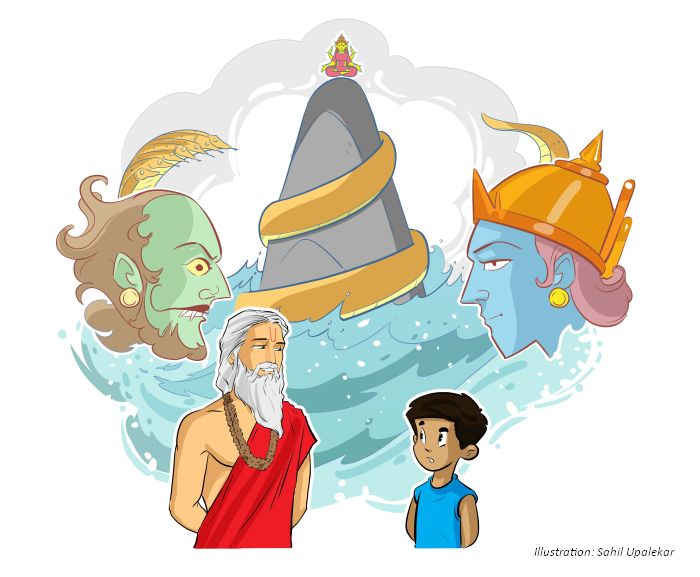Churning the ‘matter’
- POSTED ON: 7 Mar, 2023
- TOTAL VIEWS: 187 Views
- POSTED BY: Jagadeesh Kanna | Article: Madhumitha Srinivasan
- ARTICLE POINTS: 150 Points
As promised, Sukracharya shares a story that he says would help Meghnath understand why Nature favours matter, against antimatter.
Sukracharya: You may be familiar with this story but, this time, we are going to interpret it a bit differently.
Meghnath: Which story is this, guru?
Sukracharya: The one about the Devas and the Asuras churning the ocean to get the divine nectar.
Meghnath: The one where the Devas used a cheap trick to drink the entire pot of nectar!
Sukracharya: That’s what it seems like. But let me tell you the story from a Science perspective. Let’s see if you understand it.
Meghnath: Okay. Let me see if your version makes me feel any better.

Sukracharya: To begin with, imagine the movement of the universe to be similar to the churning of the cosmic ocean. The universe where the solar system, galaxy and every celestial object exists…
Meghnath: Isn’t there a huge black hole at the centre of every galaxy that makes all the stars and the planets go round and round?
Sukracharya: Yes. Now consider the black hole as the churning point. All matter like planets and stars are the Devas and all anti-matter like dark matter/vacuum are the Asuras.
Meghnath: But churning means going back and forth, right? Not just going around in one direction.
Sukracharya: Every black hole, star and even planet goes through something called Pole Shift, which causes changes in their rotational movement. It is basically a change in a planet’s magnetic field so that the positions of magnetic north and magnetic south are interchanged.
Meghnath: I have read that Pole Shift happens in the sun quite frequently.
Sukracharya: Exactly. Now imagine that the galaxy’s spiral arms are Vasuki, the King of Serpents, who is wound around Mount Meru. The black hole’s tornado-like centre is Mount Meru.
Meghnath: What about Lord Vishnu who took the form of a turtle to hold up Mount Meru and prevent it from sinking into the ocean?
Sukracharya: The hypothetical equivalent could be the “nuclear bulge” at the centre of galaxy.
Meghnath: Wow! This story seems like something created to store scientific knowledge in an encrypted format.
Sukracharya: Probably yes. Stories are one of the most effective and critical tools in science communication.
Meghnath: I can see why! But before we get into the story, can you clarify a doubt? Blackholes usually suck everything in. But in this story, precious things come out of the ocean.
Sukracharya: As stated by Newton’s Law, every action has an equal and opposite reaction. When there is a black hole to suck things in, why can’t there be a “white hole” from which things come out?
Meghnath: This is the first time I am hearing about this. The way you put it, it sounds highly possible; much like the cosmic universe recycling itself.
Sukracharya (smiling): Something like that. Now, shall I begin the story? You may stop me if you have any doubts. Now, do you know how it begins?
Meghnath: Yes. Bali, one of the greatest Asura Kings, defeats the Devas who are weakened by Sage Durvasa’s curse.
Sukracharya: Right. Bali starts to rule all three worlds. When Indra, the King of Devas, seeks Vishnu’s help, the latter suggests that he consume the divine nectar of immortality. From here, the story indirectly describes the competition between matter and antimatter…
The author is the founder and CEO of Vaayusastra Aerospace, an IIT-Madras incubated ed-tech startup that offers Air Science workshops for children between five and 14 years.
Quiz Time!
Based on your reading of this article, and your general knowledge, see if you can get these answers right!